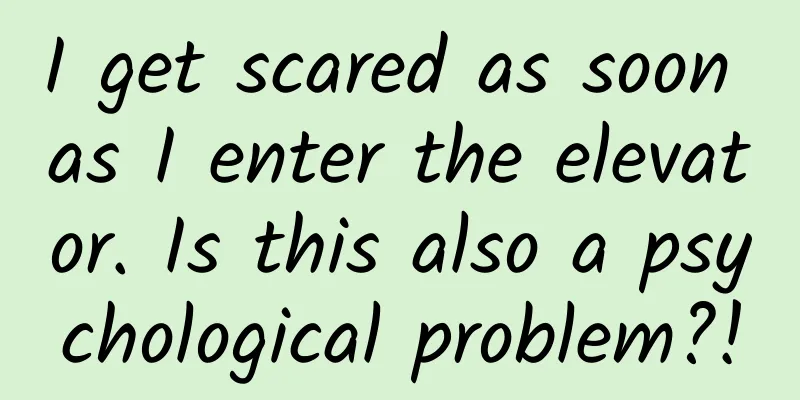I get scared as soon as I enter the elevator. Is this also a psychological problem?!

|
Review expert: Li Xianhong, national second-level psychological counselor In May this year, a netizen reported that he was forgotten by the doctor in the MRI cabin for nearly three hours during a check-up at the hospital. During the process, he did not dare to move because of the headgear. He did not realize that the door of the examination room was locked until his feet became numb and he got off the machine. He called his family to contact the hospital and then left the examination room. Once this incident was reported, it caused heated discussion among netizens. Source: The Paper Although the staff explained that there is no harm from ionizing radiation during this process, being in a closed, cramped environment for a long time may cause fear in patients and affect their physical health. In fact, a confined and small environment does not necessarily bring us a sense of security. On the contrary, it may even cause claustrophobia. Today, I will take you to learn more about claustrophobia. Source: The Paper 1What is claustrophobia? First, let's understand what claustrophobia is. The fifth edition of the Diagnostic and Statistical Manual of Mental Disorders defines claustrophobia as follows: a situational anxiety disorder characterized by fear of enclosed spaces such as elevators, airplanes, and MRI chambers. People with this disorder may avoid specific objects or situations that trigger their fear. The essence of claustrophobia is not just the fear of being in a closed space, but the fear of what might happen when you are in a closed space. So what are the symptoms of claustrophobia? Typical symptoms are: fear and anxiety reactions when in a closed space, such as psychological panic, anxiety, and physical panic attacks. When in a closed environment, many people will involuntarily feel panic, worry about what will happen, and want to escape from the current environment. They may also experience chest tightness, cold sweats, accelerated heartbeats, body tremors, suffocation, shortness of breath, and even fainting. Those with severe symptoms will even feel uncomfortable when seeing a related picture across the screen. Source: pexels 2 Why does claustrophobia occur? Studies have shown that claustrophobia is not caused by a single factor, but is affected by a combination of factors. Such as personal growth experience, psychological pressure, personality factors, etc., especially traumatic experiences in childhood. Psychological trauma in childhood is very likely to affect normal life. For example, exposure to an overly rough or repressive environment in childhood distorts normal psychological development, making it difficult to make correct judgments about objective things, and easily causing some psychological problems. Generally speaking, the possibility of phobia is related to the following factors. One is family education and upbringing methods . For example, overly strict or dogmatic education methods will affect a person's psychosocial development and affect the psychological development process of children. The second is personality and genetic factors . Individuals who experience psychological trauma or major life changes in their childhood, or who show timidity and shyness before the age of 3, are more likely to develop claustrophobia as adults. The third is biological factors . Scholars have found that the postsynaptic 5-HT receptors of individuals with claustrophobia are more sensitive than those of ordinary people. 5-HT is an excitatory neurotransmitter that plays an important role in the conduction of excitation. People with sensitive 5-HT receptors are more likely to have emotional fluctuations and may have more intense reactions to claustrophobic environments than ordinary people. Other factors that cause claustrophobia are still under study. Source: pexels 3How to deal with claustrophobia? Claustrophobia has only been in people's sight for a short time, and people have little knowledge of it and do not pay enough attention to it. If you find yourself suffering from claustrophobia, how should you deal with it? First of all, you should cultivate a positive attitude to deal with it, do not have excessive fear and phobia, actively seek medical treatment, and intervene and treat it as soon as possible. Here are some methods to treat claustrophobia. Psychological induction is currently the most common method for psychological treatment of this disease . This method is used in the prevention and early treatment stages of claustrophobia. During the treatment process, the psychologist first performs hyperbaric oxygen therapy on the visitor, and then conducts scientific psychological induction based on his or her response in specific situations. During psychological treatment, the patient should feel the care of the medical staff and gain the patient's full trust. Starting from the patient's psychology, the patient is encouraged to face it positively and take the initiative to overcome the fear, as the patient knows that he or she does not need to be afraid but cannot control it. The second is flooding therapy , which is based on the client's previous psychological counseling. The psychologist suddenly puts the client in a fearful situation, such as a small, confined space, and guides the client into the fearful situation without allowing him to escape. The advantage of this method is that it works quickly. Under repeated stimulation, the client finds that although he is in an environment that makes him uneasy and fearful, the thing he fears has not happened. Practice and facts will gradually make his fear disappear. The third is drug sedation . Benzodiazepines are generally recommended for mild, conscious sedation. However, drug treatment may cause side effects, so it is generally not the first choice for treatment. The fourth is cognitive therapy , that is, psychological workers help visitors analyze the object of fear, establish correct cognitive concepts, and use correct cognition to help visitors eliminate the fear in a specific environment. In addition, there are also drug hypnosis, direct hypnosis, and the combination of Chinese and Western medicine for treatment. Among the above methods, the most commonly used are psychological induction and cognitive therapy. Mild patients are recommended to adopt psychological treatment in the early stage of the disease, and early intervention will achieve twice the result with half the effort; severe patients are generally assisted by doctors and undergo drug intervention on the basis of psychological intervention. Please listen to the doctor's advice on the specific treatment method! I hope that everyone has a basic understanding of claustrophobia, can avoid excessive fear of a specific environment, and effectively prevent claustrophobia. If you find yourself with corresponding symptoms, don't panic, face it positively and seek help from a doctor. |
>>: Be careful! Someone is spying on your privacy!
Recommend
Can exercise offset the harm of staying up late?
As the concept of fitness becomes more popular, m...
Are the flowers blooming early in Beijing? Will they bloom again in the spring?
Audit expert: Yang Yanhui Senior Landscape Engine...
Hyundai Motor participates in CES Asia 2018 to strengthen cooperation in AI and autonomous driving
On June 13, Hyundai Motor participated in the &qu...
If I give you 10 million, do you know how to spend it? Mainstream channel promotion and delivery combination strategy
This article is based on the industry background ...
Starting from the new version update of WeChat, will there be a battle between Toutiao and WeChat?
Today, WeChat officially updated to version 6.5.4...
The Nth failure of the "Three-Body" IP
It took only half a month for "The Three-Bod...
A complete set of activity operation planning and promotion ideas
The product is like a singer, and the operation i...
Honor FlyPods Pro review: Innovative bone voiceprint technology is here to create a new mode of exclusive voice unlocking
Bluetooth headsets have long won market recogniti...
WeChat Mini Program has been taken offline due to violations of regulations. What should we do if the Mini Program has been taken offline due to violations of regulations?
Before we knew it, WeChat Mini Programs have been ...
1.31 million mu of cotton in Xinjiang is fully planted! I won't allow anyone to miss such a smooth spring farming scene!
丨(Image source: Xinhua News Agency) As the saying ...
Why does the skin age?
Anti-aging can be said to be one of the mainstrea...
Does a child's IQ come from the father or the mother? Genetics experts reveal the secret
Have you noticed that we often say "alma mat...
Unboxing the TD-LTE iPad Air
In terms of network support, the new 4G iPad suppo...
Qinling giant panda family has four generations living under one roof
In the past two days, the news that the Qinling g...
Please set your alarm and come enjoy the moon and three planets together!
February 2, 2024: February's three bright pla...









